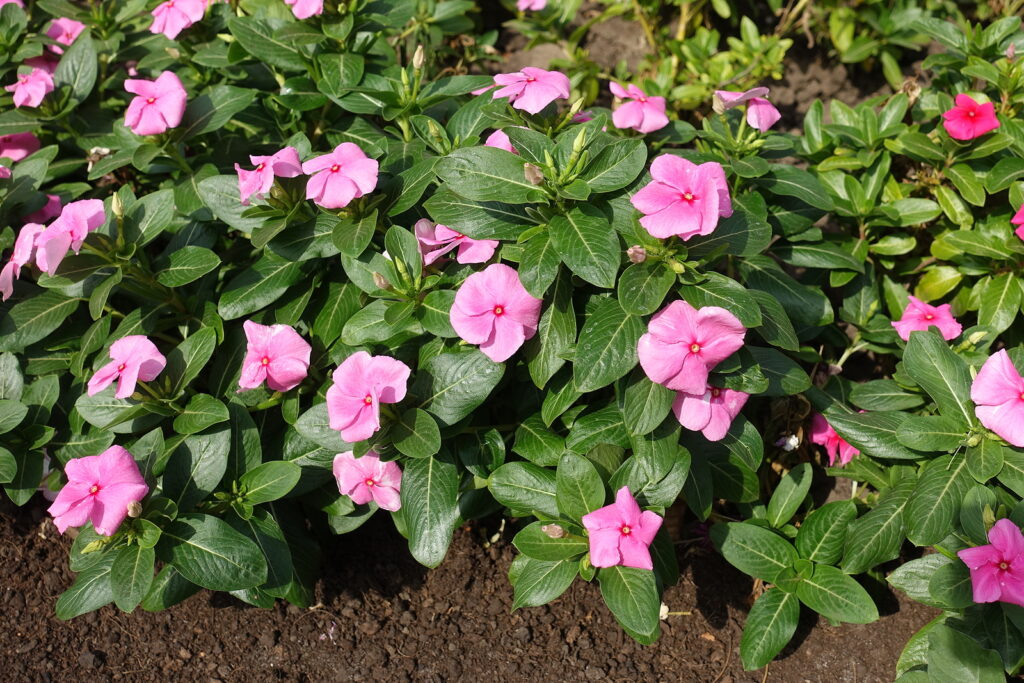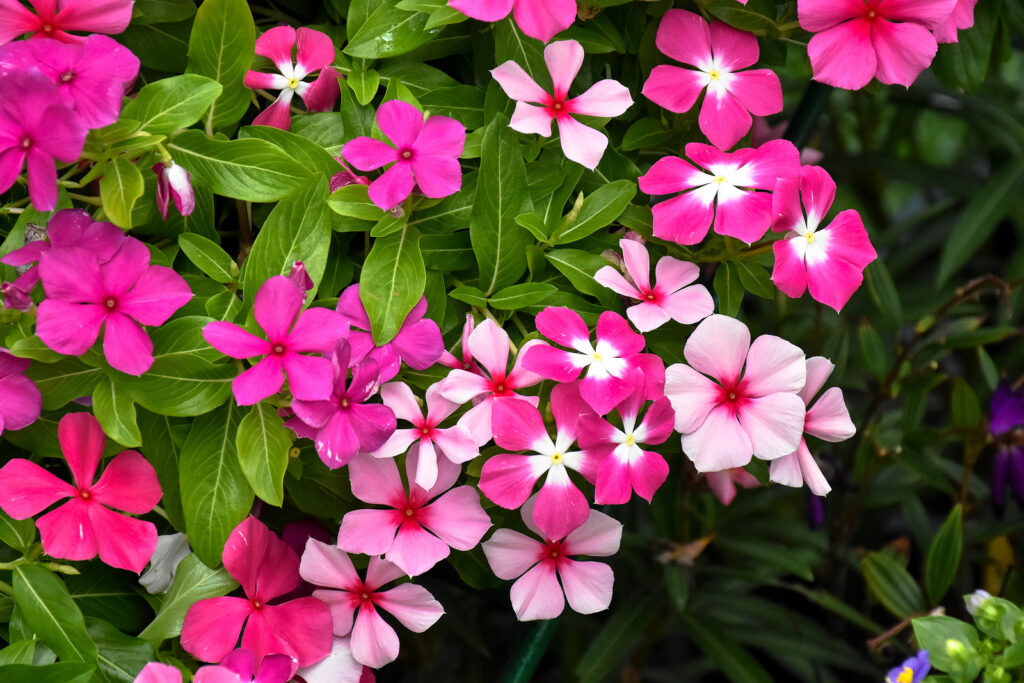Vinca rosea (Catharanthus) is a colorful evergreen groundcover with colorful white and pink flowers. Vinca rosea is a perennial usually treated as an annual. It is sometimes called Madagascar periwinkle, but it should not be confused with the evergreen groundcover called vinca or periwinkle.
Catharanthus is a good ground cover choice for summer an autumn in hot climates. It thrives in dry or humid heat. Plants can grow 1 to 2 feet tall. Leaves are deep glossy green and the flowers are 1.5 inches across and phlox like. Colors include pure white, white with rose or red eye, blush pink, clear cotton candy pink or bright rose.
Catharanthus keeps blooming after zinnias and marigolds are finished. Catharanthus will keep blooming into early winter in frost-free regions.

Get to know Catharanthus
- Plant type: Annual in Zones 2-8, perennial in Zones 9-11
- Growing Zones and range: 2-11
- Hardiness: Thrives in the heat; does not grow well in cool weather.
- Height and width: 4 to 14 inches (10-35cm) tall, 4 to 12 inches (10-30cm) wide
- Foliage: Small bushy plants with glossy oblong dark green leaves 1-3 inch long
- Flowers: 5-petaled, periwinkle-like flowers are solitary or brone in terminal cymes
- Flower colors: Pink, magenta, salmon, and white
- Bloom time: Summer to fall
- Uses: Mass as a bedding plant; grow in containers
- Common name: Vinca rosea, Madagascar periwinkle
- Botanical name: Catharanthus roseus
- Family: Apocynaceae
- Origin: Madagascar
Where to plant Catharanthus
- Plant Catharanthus in full sun in Zones 6-11. In hot summer regions, plant vinca rosea where it will be shaded in the afternoon.
- Grow Catharanthus in average garden soil; add aged compost to enrichen the soil.
Catharanthus uses
- Use Catharanthus in borders and pots.
- Use Catharanthus as edging in beds and borders.
- Catharanthus are showy cascading from window boxes or hanging baskets.
- Pot up Catharanthus before the first autumn frost and bring them indoors to grow.
When to plant Catharanthus
- Sow seeds in the garden or set plants outdoors in spring after all danger of frost has passed.

Planting and spacing Catharanthus
- Space Catharanthus 6 to 12 inches (15-30cm) apart.
- Sow seed 1/8 inch deep in evenly prepared soil.
How to water and feed Catharanthus
- Keep the soil evenly moist for vinca rosea. Once established plants will get by with infrequent water.
- Fertilize vinca rosea with a time-release all-purpose fertilizer at planting time.
Catharanthus care
- Mulch around plants to conserve soil moisture.
- Trim plants back by one-third in late summer to encourage new growth and flowering
Catharanthus pests and diseases
- Blights, stem rot, leaf spots, yellow asters and spotted wilt virus can occur.
- Spider mites and whiteflies can attack plants growing indoors.

Catharanthus propagation
- Sow seed in warm soil in early spring.
- Sow Catharanthus at 78° to 80°F (26°-27°C) for 3 days, then 75° to 78°F (24°-26°C) for the remainder of the 7- to 15-day germination period.
- Root softwood cuttings in late spring or semi-ripe cuttings in summer.
Catharanthus varieties to grow
There are several cultivars of Catharanthus roseus; here are a few:
- ‘Carpet’ is 4 inches tall and 24 inches wide; use for baskets, window boxes, and rock gardens.
- Cooler Series grow best in Zones 3-4; they are compact and produce pastel to deep rose-pink and white flowers
- Pacifica Series branch from the base and bar large lilac, pale pink, and white flowers.
- ‘Parasol’ is upright and bears large white flowers with deep red eyes.
- Pretty Series bears flowers in shades of red, pink, and whites. ‘Pretty-in-Pink’, ‘Pretty-in-Rose’, and ‘Pretty-in-White’ are All-America Selections.















